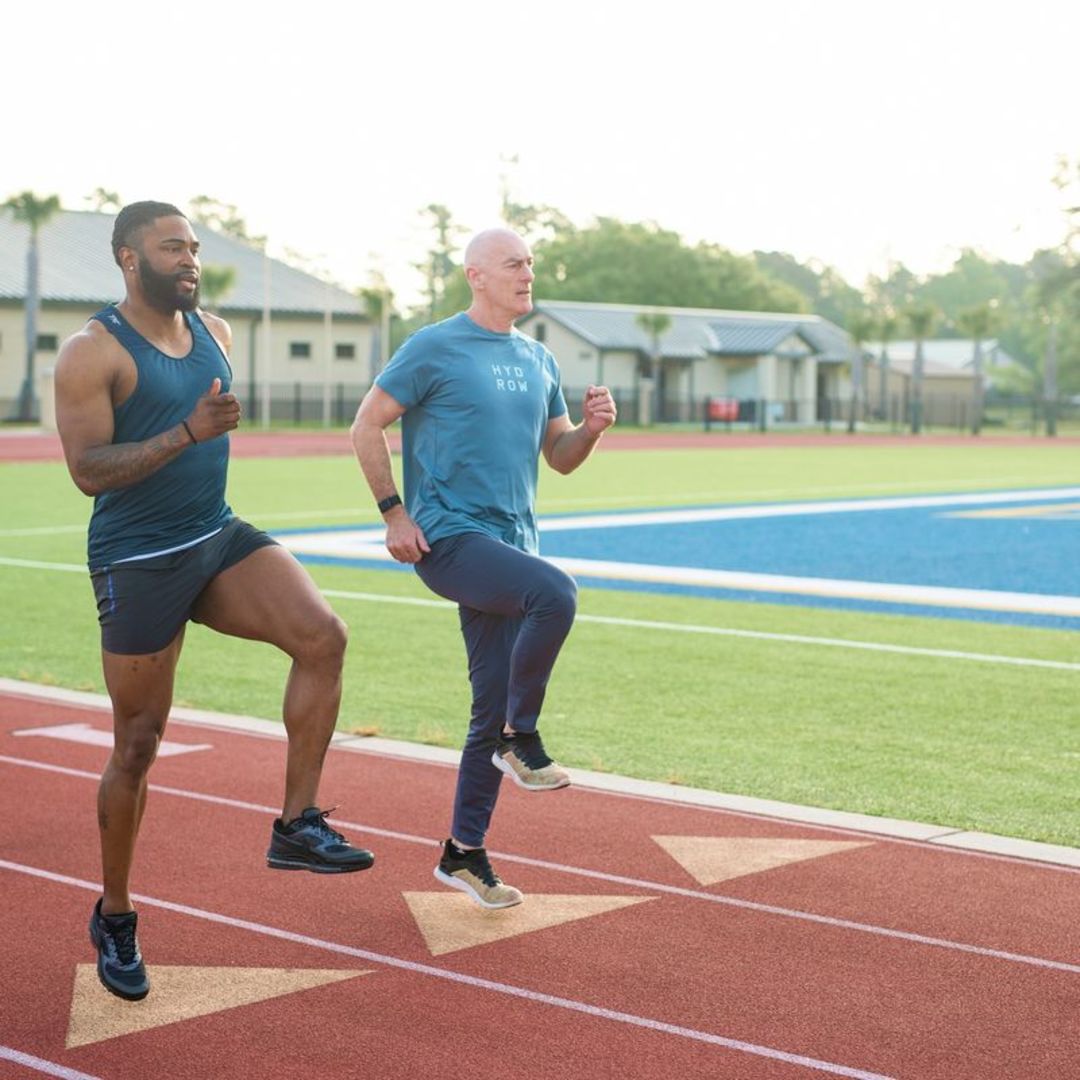How to Start Exercising When You’re Out of Shape

It’s no secret that working out consistently is hard work — and even harder if you’re feeling out of shape after taking a break from exercise or not working out at all. If you’re looking to launch a brand-new fitness journey, you’ll be happy to know that there are a ton of benefits of working out — and even more ways to make the process of getting back into shape far less daunting.
With the right approach to your workouts, some motivation, and a dash of self-compassion and patience, you’ll be on your way toward getting in shape and making fitness a more central part of your daily routine.
Read on to learn more about:
Let's dive in!
Exercising when you’re out of shape: Why it’s worth it!
Beyond promoting your overall health and well-being, exercising consistently offers a slew of both mental and physical benefits that make it worth the extra effort of getting into an exercise groove.
On the physical side, exercise leads to improved cardio and fat burn, increased energy levels, better bone health, and increased muscle strength and flexibility — along with longer-term perks such as a lower risk of chronic diseases and improved immune functions.
Mentally, those who exercise typically experience increased self-confidence, better stress relief, and cognitive benefits.
Why exercising when you’re out of shape can feel hard
Feeling intimidated about launching into a brand-new fitness routine from scratch or after you’ve been out of the game for a while? You’re not alone.
The effects of starting physical activity and exercise when you’re out of shape can feel scary. Whether you’re worried about dealing with your loss of conditioning and stamina, muscle weakness, or reduced cardio endurance, the fact of the matter is that starting from the ground up can be physically challenging — and potentially uncomfortable or even painful.
There are also mental hurdles to jump over. For instance, if you’ve found it difficult to carve out time in your day for a workout or found it hard to stay motivated, you’ll have to be really intentional about dedicating time and effort to your new routine. It’s also common for people who are out of shape to be nervous about failing, especially if they’ve had previous negative experiences with working out in the past.
Feeling overwhelmed? Don’t worry! Keep reading for some ways to make your journey toward physical fitness a whole lot easier.
13 tips for starting exercising when you’re out of shape
While there are certainly physical and mental challenges associated with exercising when you’re out of shape, the great news is that there are several things you can do to make this process easier.
Use the 13 tips below to help you find — and stick to! — a routine that works for you, including:
Talk to a healthcare professional
Set realistic goals
Choose activities you enjoy
Start slowly
Warm up and cool down
Listen to your body
Prioritize rest and recovery
Practice proper form
Mix it up!
Hydrate, hydrate, hydrate
Eat well
Stay consistent
Be patient
Let's get started!
1. Talk to a healthcare professional
While it’s tempting to hop right on an exercise machine the second you feel that urge for change coursing through your veins, it’s always worth consulting a medical professional before you dive into any new exercise routine.
Your doctor can help you assess your current health and identify any potential risks so you can select the best workouts for you and modify them according to your individual needs. A doctor can also weigh in on your current cardiovascular health, respiratory function, and bone and joint health to ensure you’re not putting yourself at risk of injury or placing any undue stress on more vulnerable parts of your body.
Speaking with a medical professional ahead of time can also help keep you feeling more motivated and accountable for completing your workouts.
2. Set realistic goals
Looking to run a marathon after a month? Not so fast! Setting goals is an incredibly important part of motivating yourself to work out, sticking with a routine, and celebrating your progress, but it’s important to make sure your goals are realistic — especially at the beginning.
While it’s great to aim high and push yourself, trying to do too much in too short a time can lead to frustration, burnout, and even injuries. What happens next is the opposite of what you want: feeling too defeated to work out or hurting yourself to the point where you need to take an extended break.
When setting your goals, we recommend:
Assessing your current fitness level to understand honestly where you stand.
Being specific about what you hope to achieve (making your goals quantifiable helps!).
Setting short-term and long-term goals so your milestones feel more manageable and can be celebrated along the way.
Being flexible with your goals and open to adjusting them along the way if your plans don’t work out exactly as predicted. Progress is the key here, not perfection!
Keeping a workout journal to track your workouts, accomplishments, and challenges over time. It can be wildly motivating to see how far you’ve come.
3. Choose activities you enjoy
It may sound obvious, but choosing workouts that you actually like doing can have a massive impact on your ability to stick to an exercise routine you’re new to. If the idea of logging an hour on a treadmill every day fills you with dread, it won’t take much to find an excuse to skip your workout.
Instead, find workouts you look forward to, whether it’s a sports league, a gym class with a friend, or an at-home workout with an instructor you really love.
Not sure what you like yet? This is a great time to sample a little bit of everything. At-home workouts in particular can offer a safe zone for experimenting with all the different workout types out there.

Did You Know?
Over 90% of Hydrow members are still active one year later.
4. Start slowly
It’s a tale as old as time: You decide you want to work out more, you devote all of your time and energy toward your shiny new routine, and then you inevitably stop after finding your current approach was physically unsustainable or incompatible with your other responsibilities.
That’s why it’s key to start any new exercise routine slowly, particularly if it’s been a while since you’ve worked out. Starting slowly can help you avoid injuries by giving your body the time it needs to adjust to the new demands you’re putting on your muscles, joints, and heart. You’ll also be able to identify any limitations and adjust your workouts accordingly (“Hey, that move never hurt my knees before!”).
Taking things slowly can also help keep you motivated and committed to your fitness routine. You’ll be able to build better habits that jive with your daily schedule and build up your confidence so you’re mentally prepared to push yourself further over time.
5. Warm up and cool down
We know your time is precious and that squeezing in a workout into your busy schedule is already a challenge, but it’s always worth taking an extra couple of minutes before and after your workouts to warm up and cool down.
Warming up prepares your body for a workout by gradually increasing your heart rate, breathing rate, and blood flow to your muscles. You’ll also enter into your core workout feeling more flexible, allowing you to move around more freely and with proper form.
Similarly, cooling down after your workout will gradually bring your heart rate and breathing back to their resting levels, helping you to recover. Cool-downs also reduce muscle soreness by promoting proper stretching.
6. Listen to your body
Getting into an exercise routine means a lot of changes for your body, so it’s important to stay in tune with how you’re feeling and adjust accordingly. You may have heard the phrase, “No pain, no gain,” but there’s a difference between pushing yourself and hurting yourself. If you’re experiencing sharp or persistent pain during exercise beyond feeling the burn, be sure to slow down or stop entirely.
It’s also important to monitor your breathing — if you’re finding it hard to breathe, you might be pushing too hard or need to adjust your exercise intensity.
There’s no shame in needing to modify your exercises to match your current fitness level. Think of it as taking the steps to ensure you’re able to show up fully for your next workout without feeling injured or burnt out.

What’s your fitness style?
Take our quiz and receive a customized 14-day training program.
7. Prioritize rest and recovery
Along the same (seemingly counterintuitive) lines, a new exercise routine when you’re out of shape should also include periods of rest and recovery. For example, your weekly routine could include working out for at least 10 to 20 minutes for three to five days to start, then allotting two days toward resting up.
This will give you the time you need to prevent overtraining and give your muscles the chance to recover, preventing your chance of injuries. Many people also find that taking time to recharge actually improves their performance for subsequent workouts.
Can’t fathom the idea of sitting still? Taking a rest day doesn’t necessarily mean you’re married to your couch watching TV. Try gentle stretching, yoga, or low-impact activities to keep your body moving without overexerting yourself.
8. Practice proper form
Another way to prevent injuries and maximize your workouts is to focus your attention on maintaining proper form. Doing your workout correctly will help engage the right muscles, promote better posture and alignment, and build strong foundations that you can build on as you improve over time.
If you’re not sure what proper form looks like, we recommend hitting up YouTube for some examples or chatting with an instructor or fellow gym-goer for feedback. It can be hard to untrain your body once it gets into a particular rhythm, so try your best to start out strong with proper form — your body will thank you!
9. Mix it up!
Nowhere in the “How to Work Out” handbook does it say you have to do the same form of exercise every single day! If you’re looking for ways to avoid getting bored and target different parts of your body, be sure to mix up the types of workouts in your routine.
Here are some examples of some types of exercises you can try out:
Strength training exercises like weightlifting, bodyweight exercises, or resistance band workouts
High-intensity interval training (HIIT) workouts, which are short bursts of exercise followed by brief rest periods
Circuit training workouts that combine various exercises in a sequence
Yoga exercises to enhance your flexibility, balance and relaxation
Pilates workouts to focus on core strength, flexibility, and overall body control
10. Hydrate, hydrate, hydrate
Did you know that close to half of U.S. adults consume far below the recommended amount of water a day? If you’re trying to get in shape, it’s even more important to keep a water bottle handy to stay hydrated before, during, and after your workouts.
Drinking water helps you maintain your energy levels, lubricate your joints, and reduce the risk of muscle cramps, in addition to regulating your temperature and reducing your risk of overheating.
You may also have to monitor your water intake depending on the types of workouts you’re doing. For example, longer workouts, higher-intensity workouts, or outdoor workouts in warm weather will require you to hydrate more to make up for the liquids you sweat out.
11. Eat well
Additionally, focusing on consuming a nutritious diet can help in your journey to get into shape. Eating better will provide you with the energy you need to fuel your workouts, promote muscle repair and growth, and support a healthier metabolism.
To start incorporating more nutrition into your diet, we recommend:
Planning your meals for the week ahead of time
Choosing whole, unprocessed foods
Controlling your portion sizes
Eating balanced meals
Reducing your salt and fat intake
Eating nutrient-rich snacks
Related blog: Should You Eat Before Working Out?
12. Stay consistent
Working out consistently is no walk in the park (even when you’re literally walking in the park). However, trying your best to stick to a schedule can have massive benefits over time. By building exercise into your daily routine, you’ll make it easier to dedicate the time and effort needed for your daily workout (and maybe — gasp! — even look forward to it).
Consistent exercise also allows your body to adapt to its new normal and leads to gains over time in your strength, endurance, flexibility, and overall fitness.
If you’re looking to get into shape, keep in mind that doing something is always better than doing nothing and that not every day has to be 100% perfect in order to count.
13. Be patient!
One of the most important parts of starting to work out after being out of shape is to be patient and kind to yourself. Getting into shape requires hard work, and there will inevitably be days where you’re just not feeling it. It’s okay to make mistakes, and you’ll feel a lot better if you can see them as learning opportunities along your journey.
Getting in shape also takes time, so if you’re not immediately seeing the magical results you imagined, don’t panic. By committing yourself to working out more consistently, change will inevitably come — just trust in the process and try your best not to get discouraged.
Working out to get in shape: Final thoughts
Whether you’re recovering from an injury, getting back into shape after some time away, or starting your fitness adventure from scratch, there are a ton of ways to make sure you keep your body and mind safe and sound along the way.
If you’re looking for a new type of workout, we recommend checking out an at-home row machine like Hydrow. Our library of over 4,000 workouts includes rowing, yoga, pilates, strength training, and circuit training workouts for people of all fitness levels, all led by world-class Athletes to help keep you motivated and excited about your workouts.
Learn more about Hydrow and how rowing can get you in shape today!

Explore Hydrow
Learn more about how you can transform your fitness routine with a rowing machine.







